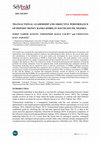Papers by AYOGOI S I M O N YAIBIMI

The Seyboldreport Journal, 2023
Prior studies have examined the relationship between transactional leadership and performance of ... more Prior studies have examined the relationship between transactional leadership and performance of employees and organizations with conflicting empirical evidences and methodological flaws. However, the current study takes into consideration of the limitations of the prior studies and investigated the nexus between transactional leadership and objective performance of DMBs in South South, Nigeria. The study adopted a cross sectional survey design and selected a sample of sixteen banks and three hundred and twelve (312) workers, consisting of managers and employees. Data were collected by means of structured questionnaire and statements of financial positions and income statements. From the analysed data, results demonstrated that contingent sanctions of transactional leadership had no significant effect on objective performance of DMBS, contingent pecuniary rewards of transactional leadership had a significant effect on objective performance of DMBs while contingent non-pecuniary rewards of transactional leadership had no significant effect on objective performance of DMBS. In line with the findings, we conclude that contingent pecuniary rewards are effective as an approach of transactional leadership in DMBs. We recommend that contingent pecuniary rewards should be given prominence in applying the transactional leadership to enforce performance of DMBs while contingent non-pecuniary rewards and contingent sanctions should be considered also in the transaction exchange relationship between managers of transactional style of leadership and subordinates in the banking sector.

Journal of social sciences, 2020
ABSTRACT
A clear and concise organizational structure is the brainchild of a systematic thought p... more ABSTRACT
A clear and concise organizational structure is the brainchild of a systematic thought process. And understanding the structure of an organization is very cardinal for all stakeholders that are associated with the organization. An organization is like the structure of a human body with its parts, it is composed of elements and linkages of these elements which clearly defined the nexus between elements working together to form the whole. Review of the literature did show organizational structure as an arrangement of people within the organization which will work in synergy to best achieve the company goals. A typical structure is portrayed for all to see in the form of a diagram called organogram.
Meanwhile, the design of an organization which has a very significant impact on the performance of the organization is often mistaken by students and employees of various organizations. This mix-up has reduced or affected many individuals the required knowledge in setting a workable design or how best a particular organization should be designed. Van de Ven et al (2013) opined that “much has been learned, and even more needs to be learned, about designing organizations and institutions”. Also Mintzberg (1979, p.12) as cited in Malone (1986) says “…… the research on the structuring of organizations has come of age but the literature has not; there is the need to …. Synthesize it into manageable theory.” The reasons behind this paper is to take a bold step forward in presenting relevant literatures in this area to aid both scholars and industry practitioners and also add to the existing body of knowledge.
The present study is descriptive in nature and library method was used for data collection.

International journal of scientific and engineering research, 2020
There is a positive relationship between advertising and the performance of SMEs. Studies have sh... more There is a positive relationship between advertising and the performance of SMEs. Studies have shown that more than 95 % of small and medium enterprises (SMEs) growth is halter by their limited financial resources. SMEs are vital to economic development in Nigeria and they are the key source of employment and contribute significantly towards the Gross Domestic Products (GDP). A cross-sectional survey design was put in place for the study. The unit of analysis was organization while the owner/managers of SMEs were the respondents. Systematic, simple random and snowbell sampling techniques were employed to collect the needed data for the study. A sample size of 40 SMEs covering all sectors that exist in the study area was drawn from a population of 0ver 50 SMEs. Descriptive and Inferential statistics were used to empirically and statistically analyze the data collected for the study with the aid of Statistical Package for Social Science (SPSS) version 20. Regression analysis was used to test the hypotheses. Performance variables include Return on Investment, Customer Satisfaction, Market share and Sakes Growth. The findings of the study revealed that advertising practices made up of Customer Relationship Management with a p-value of 0.012, Market segmentation with 0.038, Quality with 0.026 and Market Promotion 0.031 have significant positive effect on SMEs performance, while cooperation with 0.002 was not found to be a predictor of SME performance in yenegoa Metropolis of Bayelsa State, Nigeria. The study found that advertising spending have positive effect on the performance of SMEs in the study area. It therefore concluded among others that SMEs managers and operators should always employ appropriate marketing practices for their firms.
Drafts by AYOGOI S I M O N YAIBIMI
Draft article, 2021
This brief article is therefore intended at taking a subjective and objective appraisal of the pe... more This brief article is therefore intended at taking a subjective and objective appraisal of the performance in the past 365 days of the Governor Douye Diri’s led administration in Bayelsa State.








Uploads
Papers by AYOGOI S I M O N YAIBIMI
A clear and concise organizational structure is the brainchild of a systematic thought process. And understanding the structure of an organization is very cardinal for all stakeholders that are associated with the organization. An organization is like the structure of a human body with its parts, it is composed of elements and linkages of these elements which clearly defined the nexus between elements working together to form the whole. Review of the literature did show organizational structure as an arrangement of people within the organization which will work in synergy to best achieve the company goals. A typical structure is portrayed for all to see in the form of a diagram called organogram.
Meanwhile, the design of an organization which has a very significant impact on the performance of the organization is often mistaken by students and employees of various organizations. This mix-up has reduced or affected many individuals the required knowledge in setting a workable design or how best a particular organization should be designed. Van de Ven et al (2013) opined that “much has been learned, and even more needs to be learned, about designing organizations and institutions”. Also Mintzberg (1979, p.12) as cited in Malone (1986) says “…… the research on the structuring of organizations has come of age but the literature has not; there is the need to …. Synthesize it into manageable theory.” The reasons behind this paper is to take a bold step forward in presenting relevant literatures in this area to aid both scholars and industry practitioners and also add to the existing body of knowledge.
The present study is descriptive in nature and library method was used for data collection.
Drafts by AYOGOI S I M O N YAIBIMI
A clear and concise organizational structure is the brainchild of a systematic thought process. And understanding the structure of an organization is very cardinal for all stakeholders that are associated with the organization. An organization is like the structure of a human body with its parts, it is composed of elements and linkages of these elements which clearly defined the nexus between elements working together to form the whole. Review of the literature did show organizational structure as an arrangement of people within the organization which will work in synergy to best achieve the company goals. A typical structure is portrayed for all to see in the form of a diagram called organogram.
Meanwhile, the design of an organization which has a very significant impact on the performance of the organization is often mistaken by students and employees of various organizations. This mix-up has reduced or affected many individuals the required knowledge in setting a workable design or how best a particular organization should be designed. Van de Ven et al (2013) opined that “much has been learned, and even more needs to be learned, about designing organizations and institutions”. Also Mintzberg (1979, p.12) as cited in Malone (1986) says “…… the research on the structuring of organizations has come of age but the literature has not; there is the need to …. Synthesize it into manageable theory.” The reasons behind this paper is to take a bold step forward in presenting relevant literatures in this area to aid both scholars and industry practitioners and also add to the existing body of knowledge.
The present study is descriptive in nature and library method was used for data collection.